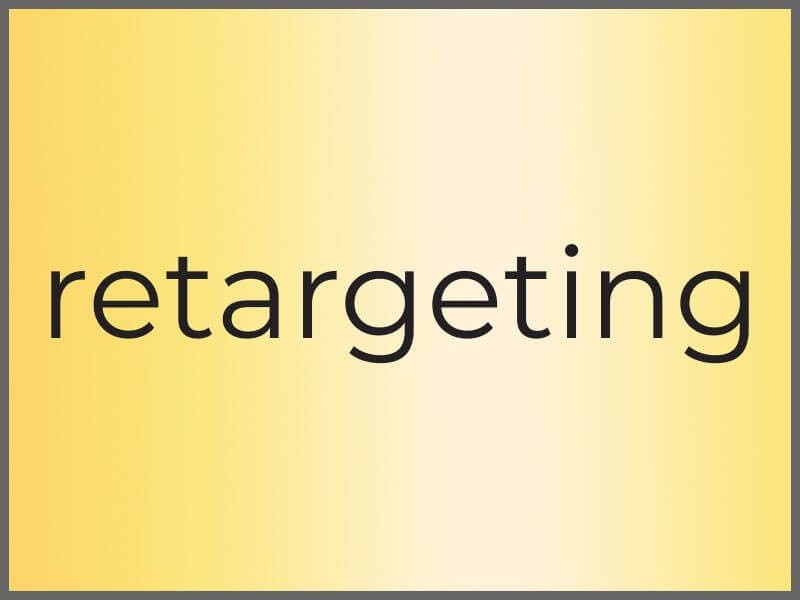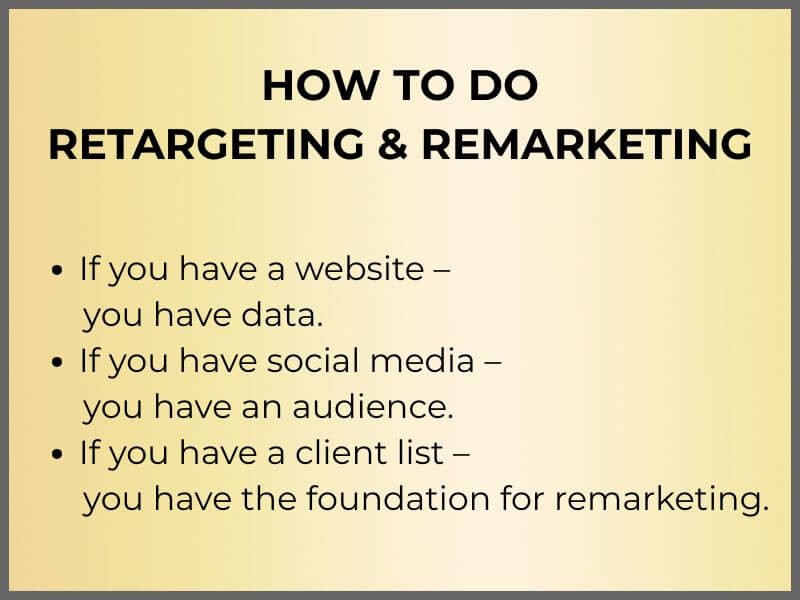
Why do people click and disappear? They check your offer or product, send an inquiry, browse dates. And then they're gone. They don’t book or buy, and you know they were close. What can you do when someone shows interest but doesn’t take the final step?
Imagine this. Someone visits your website, checks your offer and… disappears. No inquiry, no call, nothing. And you know how close they were to making a decision.
What now? That’s when retargeting and remarketing come in.
Both strategies exist with one simple goal: to bring back people who have already shown interest. And although they sound similar (and are often used interchangeably), there is a difference – and that difference can impact your profit.

Someone visits your website, looks at what you offer and leaves. No inquiry. No booking. No purchase. Nothing.
Maybe they were interrupted, or just checking prices and changed their mind. Or maybe they forgot.
In any case, they’re gone.
And most business owners stop there. They let that person, that lead, slip away without a single reminder. Big brands don’t do that.
What do they do differently?
When someone comes but doesn’t buy, it doesn’t mean “no”. In most cases, it means “not yet”.
That’s why they use retargeting – a strategy that keeps the conversation going with someone who’s already looked at a product or service.
Example: You have an online store with sneakers. Someone clicks on one model, checks it out, adds it to the cart… and closes the site. The next day, that person reads the news or scrolls through Instagram. Among the ads, they see those same sneakers they viewed yesterday.
That’s not a coincidence. That’s retargeting.
How does it work technically?
Retargeting uses so-called cookies, small tags that remember the visitor.
They don’t know the person’s name, surname, or phone number. But they know that someone:
When that person later visits other websites or apps, ad networks (like Google or Facebook) show them an ad based on their previous interest.
And now the key question – what do you show?
You don’t show an ad saying “here’s everything we offer”.
That’s too broad. Instead, you show an ad for exactly what the person viewed, such as:
- “Forgot this bag? It’s still available.”
- “The apartment in Poreč you viewed – now 10% off in June.”
- “The sneakers in your cart are still waiting for you.”
That kind of ad feels personal and familiar. There’s no need to explain who you are or what you offer – the person already knows.
Why does it work?
Because retargeting:
There’s no pushing. Just a gentle “hey, it’s still here if you’re interested”.
In sales, there’s a big difference between someone who asks and someone who actually buys. If someone doesn’t remember you, they can’t give you a second chance. Retargeting is here to make sure they don’t forget you.

While retargeting “follows” people who visited your website, remarketing is based on those who have already given you some form of contact. This can be an email address, a phone number, or even a physical address. Such contacts are valuable because they have already shown greater interest and taken the first step.
Remarketing means reaching out to that person again directly. Most often through email, SMS, or messages sent via apps people use every day – such as WhatsApp, Viber, and similar.
That message goes exactly where the person can see it and read it when it suits them, such as:
Instead of letting that go forgotten, you make the first move. And not with a generic message like “Here’s our offer,” but with a message that makes sense to that person.
For example:
- “Still interested in massages? We have an opening this Thursday afternoon.”
- “We saw you rented our camper for a trip last year – this weekend we have a special discount.”
- “Your last check-up was 7 months ago – would you like to book a new appointment?”
These kinds of messages don’t feel like advertising, but more like a reminder from someone who knows who you are and what you care about.
That is the essence of remarketing – it is not a generic message sent to everyone, not an ad guessing what might interest you, nor is it random communication.
It is not a cold message sent to everyone.
It is a contact that comes at the right time, in the right way, with a message that addresses a real need.
In small businesses, this can mean the difference between someone who never shows up and someone who comes back month after month. That’s why remarketing is not just for “big” companies.
If you have the email address of someone who contacted you, you can send them a message like this. You don’t need anything expensive or complicated. Just a bit of goodwill and the desire to stay in touch.
That’s remarketing. Personalised. Direct. And effective.
Look at Amazon. Booking.com. Zalando. IKEA.
These websites know who visited, what they looked at, and when they left. And they don’t forget those people easily.
If you’ve ever browsed their products, chances are those same products “greeted” you on other sites. Maybe on a news portal. Maybe on YouTube. Maybe on Instagram. And that’s no coincidence.
Likewise, it’s possible you received an email about a product left in your cart. Or a message about a discount that expires today. Or a suggestion for a similar product that might suit you. All of that falls under retargeting and remarketing.
These brands don’t wait for you to remember them. They make sure to stay present even after you leave the website.
And they don’t do it randomly – they do it systematically.
Big companies don’t waste time or money hoping someone might come back. They target those who have already shown interest. Because they know one simple thing – most people don’t buy right away.
Some need a reminder. Some need to be convinced again. Some just need more time. And that’s why they send multiple messages. Sometimes one reminder is enough. Sometimes it takes a few.
And that’s not pushing – it’s a way of communicating that follows actual customer behavior and delivers results.
Serious companies use systems that handle all of this automatically. They recognise when someone has been on the website, react in time, and adjust the message to what the person viewed.
So, do you need a million-euro budget for this? No.
You need to stop letting go of people who were already close to deciding and have a simple plan for staying present a bit longer after they leave.
Because sometimes that “bit longer” matters a lot.
Many small business and trade owners believe retargeting and remarketing are reserved only for large companies. They think it requires a massive budget and an army of marketing experts. That is simply not true.
These strategies have long been used by small businesses that want to sell smarter. It does not matter if you run apartments, a salon, or a webshop, the principle is the same:
- If you have apartments, you can reach visitors again who viewed certain dates but did not send an inquiry.
- If you run a salon, you can reach out to clients who have not visited you in several months and remind them of your service.
- If you have a webshop, you can show ads to people who viewed products but did not complete a purchase.
All of this works on a simple rule – you must not let go of people who already showed interest. They are the closest to buying, and there is no need to find them again.
The best part is that everything can be automated. You focus on your business while the system reminds your visitors and clients.
There are proven solutions for this:
Retargeting and remarketing work just as well for small businesses and trade, and the difference is visible in a higher number of returning customers and bookings.
In addition, automate as much as possible. That way, you can focus on your daily work knowing that those who have already visited you will not be forgotten.

If you do not have a webshop, you can still use retargeting and remarketing.
For this type of advertising, you do not need a webshop. A webshop is just one form of selling, but not the only one where this makes sense.
Most of your potential customers have already reached you, and what you need most is the willingness to focus on the relationship with the people who are already there.
Retargeting and remarketing do not mean “spamming”, but making sure you don’t lose those who already showed interest.
The first and most expensive mistake? Letting go of people who already showed interest without any reminder. A visitor comes, looks, disappears. And remains lost forever.
The second mistake? Ads that have nothing to do with what the person previously viewed. If someone was on your site looking at a specific product or service, and then sees an ad for something completely different, it does not seem serious. It gives the impression that the communication has no clear direction.
The third? Lack of a plan. Today an ad, tomorrow nothing, the day after something new, and no connection in sight. Everything looks like a string of attempts without a strategy. A system is needed that knows when, to whom, and with what message it should communicate.
The fourth mistake? No tracking of results. You don’t know who clicked, who came back, what worked and what didn’t. Without basic data, it is hard to know whether anything you are doing is paying off. And when you don’t know what works, it is hard to repeat what brings results.
Mistakes themselves are not the problem. The problem arises when they are repeated and nothing changes.
Retargeting and remarketing help when you want to stop improvising and make better use of every contact with someone who already knows you.
You do not need to do everything at once. Start with a few simple steps that almost any small business can take:
1. Set up Facebook Pixel on your website
2. Start collecting email addresses
3. Create an ad for people who already visited you
4. Send an email to former customers
5. Learn how to set it all up (or ask for help)

How many times have you bought something immediately, on the first try?
If you are like most people, you need a reminder, “that little something” that pulls you toward completing the purchase.
Why would your customers be any different?
Retargeting and remarketing are not “extra work”. They are the most affordable way to make the most of everything you have already invested in ads, your website, social media, and promotion.
The right message, at the right time, to the right person is what delivers results today.
It does not have to stay that way. Send us a message, tell us what you do, and we will help you find the best retargeting and remarketing solution for your situation.
Get in touch and let your visitors start coming back.
If you have most of this, you are on the right track.
If you have a few, you already have a foundation.
If you have almost nothing, now you know where to start.